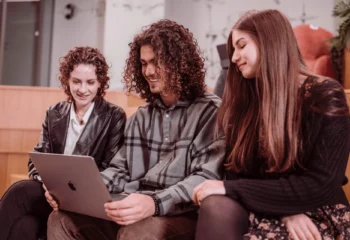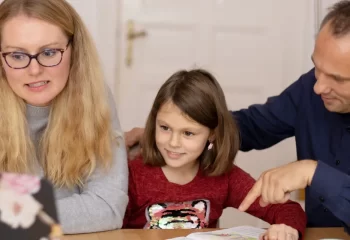Student-Teacher Interaction Basics
Growth and development depend on a positive relationship between students and teachers. Educators must create an environment that encourages children to engage with each other and learn through play, social interaction in school, and activities.
In the classroom, the teacher should be able to bring the subject matter alive for students. It can be done through effective questioning, discussions about current events, or even a few minutes of inquiry from each student.
Teacher-Student Interaction Theory
Teacher-Student Interaction is a well-known theory in education that helps educators understand the relationship between students and teachers. This theory examines the role of a teacher and the impact it can have on student learning.
Why Teacher-Student Relationships Matter
Core beliefs of the teacher-student relationship theory are that a student’s level of motivation is related to the classroom environment, which includes teacher-student interaction.
Motivation is important in student achievement because it can help students focus and stay engaged during class. Furthermore, when motivated, students can better absorb and retain this information over time.
Benefits of Teacher-Student Relationship
A positive relationship between a teacher and student can offer several benefits to both parties. Studies have shown that when students feel respected, they are more secure and comfortable in the classroom, which makes learning easier. Furthermore, relationships with teachers also encourage students to follow school rules and be on time for classes.
Challenges Facing Positive Teacher-Student Relationships
Several challenges can arise when working with children. One of the biggest challenges for teachers and students is doing the same assignment repeatedly. When it comes to grades, students may feel like they are getting punished because they did not do well the previous day.
Teachers may also feel frustrated when students do not perform well in class or fail to follow the rules. These challenges can make creating a positive teacher-student relationship difficult.
Elements of a Positive Student-Teacher Relationship
A positive student-teacher relationship is more than just teacher praise for students. For situations to improve, there are several elements that teachers and students must understand.
Consistent Communication
Teachers must communicate consistently to connect with students and receive their best effort. Teachers should attempt to use a student’s first name whenever possible, which can help encourage students to do their best work. When it comes to discipline, it is important to communicate the rules clearly and stick to consequences consistently.
Emotionally-Safe Learning Space
Safe learning spaces are sensitive and supportive of students’ personal growth. To create a positive learning environment, the teacher should know how students feel when they enter the classroom. It can include communicating with students before they enter the class and asking if they need to discuss a difficult situation.
Compassion and Understanding
Teachers should approach each interaction with compassion when working with students in the classroom. Students are more likely to respect a teacher when they understand them as a person instead of just a teacher. Acknowledging the good work of students and understanding their problems can also improve the student-teacher relationship.
Active Listening
Active listening is used to listen to students and convey understanding. It can help teachers further communicate with students about their needs and improve the relationship between the two parties.
True Equity
Equity describes the idea of fairness. When working with students, teachers should be sure that the classroom is equal for all students. The teacher should ensure that no student receives more praise or attention than another, especially regarding discipline.
Teacher-Student Interaction Activities
There are several activities that teachers can use to improve student-teacher interaction. These activities include writing positive notes or encouraging students to participate in extra credit work.
Team-Building Games
Team-building games are fun to connect with students and encourage cooperation. Games like round-robin are great ways to interact with students and make the classroom environment more relaxed.
Extracurricular Activities
Teachers can participate in extracurricular activities with students to create a positive student-teacher relationship. These activities can include going on field trips, attending sporting games, or visiting the local museum.
Personal Stories
Teachers can use personal experiences to engage with students. Personal stories help students connect with teachers because they make them feel like they can relate. It is a common strategy used in leadership and communication.
Student-teacher interaction in online learning environments
Online learning classrooms can help build relationships between the teacher and the student. It can get done through collaborative work and shared resources. Online classroom software, such as Quizizz, provides students with an engaging way to learn in the classroom. Teachers can create multiple-choice questions on any topic, which students will be able to use to gain points in class.
When working with students in online classes, teachers should create a relaxing environment that encourages students to ask questions. When students feel comfortable asking questions, they can gain more knowledge about an issue, which helps to improve overall understanding. Teachers can use this behavior of asking and answering questions to create a more interactive classroom.
Student-Teacher Interaction FAQ
Below are some of the most frequently asked questions about teacher-student relationships. This list can help students and teachers interact more effectively and build positive student-teacher relationships.
What are the benefits of student-teacher interaction?
When students and teachers have a good relationship, each party has several benefits. A positive teacher-student relationship can help students improve their understanding of the classroom material and encourage students to stay on task.
How Can you Improve Student-Teacher Interaction?
Teachers and students should work to find ways to improve their relationship. It can get done through working together on extra credit projects or giving back to each other by helping out in the classroom or a neighborhood.
Does Online Education Affect Student-Teacher Interaction?
Classrooms that use online learning environments can also benefit from improved relationships between students and teachers. Teachers can create quizzes and activities for students to work on together. It can bring the classroom together and give students a chance to help each other.
How Can Interactions With Teachers Influence Students?
A positive relationship between students and teachers can help improve students’ grades and overall behavior. A student-teacher relationship can encourage a more positive attitude in the classroom, which allows students to feel more comfortable in the learning environment.
How Important is Student-Teacher Interaction in an Online Environment?
Online classrooms can also benefit from learner-instructor interaction, which helps to enhance the learning environment further. Creating a positive teacher-student relationship benefits the student and teacher and can help improve grades and overall understanding of the classroom material.
Interaction between teachers and students is beneficial to both parties. It helps to decrease the tension that can often arise in the classroom and can help build a positive relationship between both parties.




